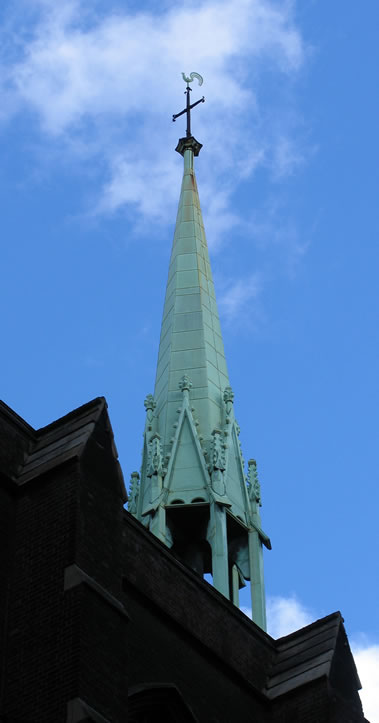Church of the Annunciation, Marble Arch, London
Local Area
The Annunciation is at the southern end of Marylebone in what is now the City of Westminster. The locality was originally known as Tyburn, from its situation near a small bourne (or rivulet), formerly called Ayebrook or Eye-brook, and finally known as Tybourn-brook which flowed into the Thames. Being in the parish of St Mary (where Marylebone Parish Church now stands) St Mary's came to be known as St. Mary at the bourn, now corrupted to St. Mary le bone, or Marylebone.
In the 1230s and 1240s the village of Tyburn was held by Gilbert de Sandford, the son of John de Sandford who had been the Chamberlain of Queen Eleanor. Eleanor was the wife of King Henry II who encouraged her sons Henry and Richard to rebel against her husband.
In 1236 the city of London contracted with Sir Gilbert to draw water from Tyburn Springs which he held to serve as the source of the first piped water supply for the city. The water was supplied in lead pipes that ran from where Bond Street Station stands today, half a mile east of Hyde Park, down to the hamlet of Charing (Charing Cross), along Fleet Street and over the Fleet Bridge, climbing Ludgate Hill (by gravitational pressure) to a public conduit at Cheapside. Water was supplied for free to allcomers.
Tyburn had significance from ancient times and was marked by a monument known as Oswulf's Stone, which gave its name to the Ossultone Hundred of Middlesex. The stone was covered over in 1851 when Marble Arch was moved to the area, but it was shortly afterwards unearthed and propped up against the Arch. It has not been seen since 1869.
Tyburn became notorious from 1196 as a place of execution. In 1571 the Tyburn Tree was erected and remained in some shape or form until 1783. A number of Roman Catholics were executed here during the Reformation.
In the sixteenth century the local landowner became Lord Portman. The original Portman Estate was an area of 270 acres and was acquired in 1532 by Sir William Portman of Somerset (1498–1557) who later became Lord Chief Justice. Initially, Sir William took assignment of a lease in respect of 11 fields and the manor of Lilleston, Middlesex (the origin of Lisson Grove). The lease had 30 years left to run and was purchased for £70 subject to an annual rental of £8. He subsequently bought the freehold of the property in June 1554 under the reign of Queen Mary. Reputedly, Sir William needed the land as a source of goat’s milk for his ailing wife and to rest cattle en route to market from his vast Dorset and Somerset Estates.
Development of the Estate was started some time later by Henry William Portman (1738-96). Orchard & Portman Streets were the first to be developed in the 1750s and Portman Square followed in 1764. The Square became very fashionable and was to owe its popularity to buildings by Robert Adam. Home House (19/20 Portman Square) built for the Countess of Home, survives today as a private hotel. James ‘Athenian’ Stuart, the architect of Montagu House, built in the northwest corner of Portman Square for Mrs Elizabeth Montagu (famous for her Bluestocking parties). It was demolished following bomb damage in 1941.
The Estate also includes Manchester Square dating from the 1770s and Bryanston and Montagu Squares, both established around 1810. The actual building was not undertaken directly by the Estate, though the architect responsible for the design and characteristics of Montagu and Bryanston Squares was James Thompson Parkinson, who was probably instructed by the Estate.
Marble Arch was designed in 1825 by John Nash as a ceremonial entrance to the courtyard of the new Buckingham Palace which he was then rebuilding from the former Buckingham House. The palace as designed by Nash was laid out around three sides of the courtyard with the Marble Arch placed on its open, eastern side. The arch was dismantled in 1850 when the new east range of Buckingham Palace was constructed closing in the courtyard. It was rebuilt by Thomas Cubitt as a ceremonial entrance to the northeast corner of Hyde Park at Cumberland Gate. The reconstruction was completed in March 1851. A popular story says that the arch was moved because it was too narrow for the Queen's state coach to pass through but the gold state coach passed under it during Elizabeth II's coronation in 1953.


